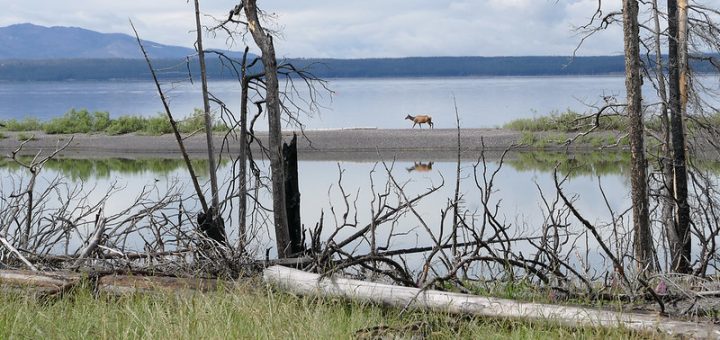R v Desautel: Aboriginal peoples outside of Canada may hold rights under s 35(1)

On April 23, 2021, a majority of the Supreme Court of Canada held in R v Desautel, 2021 SCC 17 [Desautel] that “the aboriginal peoples of Canada,” who hold rights under s 35(1) of the Constitution Act, 1982 [Constitution], are the modern successors of those Aboriginal societies that occupied lands now referred to as Canada at the time of European contact. This means that Indigenous claimants need not be Canadian citizens or residents for a court to find that they have constitutionally protected rights under s 35(1). After reviewing the majority and dissenting opinions, this case comment considers whether the Court’s confidence in its ability to decide what are deeply political questions may prove to be the harder boundary for Indigenous peoples to cross in pursuit of self-determination.
Background
In 2010, Richard Desautel travelled from his home in the United States to British Columbia (B.C.). While in B.C., he shot an elk and was charged with two offences under the Wildlife Act, RSBC 1996, c 488. Mr. Desautel defended his actions as an Aboriginal right to hunt elk under s 35(1) of the Constitution (Desautel, para 3). Mr. Desautel is a member of the Lakes Tribe of the Colville Confederated Tribes (“Lakes Tribe”) from northeastern Washington state (Desautel, para 4). He traced his claim to his ancestors, the Sinixt, whose territory spanned parts of present-day Washington and B.C. (Desautel, paras 3-4). Section 35(1) recognizes and affirms the existing Aboriginal and treaty rights of “the aboriginal peoples of Canada.” Mr. Desautel’s identity as an Indigenous person without Canadian citizenship or residency status thus posed the following question for the first time in s 35 jurisprudence: Who counts as “the aboriginal peoples of Canada”?
Procedural History
The trial record from the Supreme Court of British Columbia established that the Sinixt engaged in seasonal hunting, fishing, and gathering in their traditional territory (Desautel, para 4). An 1846 treaty negotiated between the U.S. and Britain resulted in an international boundary that divided the Sinixt’s territory without their consultation or consent (Desautel, para 5). The trial judge found that “a constellation of factors” drove the Sinixt more to the American side of their territory by the 1870s, and that this move was not voluntary (Desautel, para 5). As such, she accepted that Mr. Desautel is a member of the Lakes Tribe and that it is a modern successor of the Sinixt (Desautel, para 7). The trial record further established that members of the Lakes Tribe continued to hunt in B.C. after their relocation to the U.S. There were long breaks in this activity from the period between 1930 and 2010. Nevertheless, the trial judge was satisfied that Mr. Desautel had met the doctrinal requirement to show continuity between the modern-day practice and the pre-contact activity of the Aboriginal people, largely based on evidence that the Lakes Tribe maintained a meaningful connection to the land (Desautel, paras 5-6, 8).
The summary conviction appeal judge dismissed the Crown’s appeal. The judge reasoned that because s 35(1) is animated by the objective of reconciliation, any interpretation of “the aboriginal peoples of Canada” must encompass all modern successors of a prior-occupying Aboriginal society, whether or not the successor group still resides in Canada (Desautel, para 10). The British Columbia Court of Appeal unanimously dismissed the Crown’s second appeal, holding that a citizenship or residency requirement would overlook “the Aboriginal perspective, the realities of colonization and displacement, and the goal of reconciliation” (Desautel, para 12). Both levels of court ruled that since Mr. Desautel had lawfully entered Canada, there was no need to determine whether his right was incompatible with Canadian sovereignty (Desautel, paras 11, 13).
Decision
The central issue on appeal to the Supreme Court of Canada (“the Court”) was whether a person belonging to an Aboriginal group outside of Canada can hold an Aboriginal right within the meaning of s 35(1) of the Constitution.
Majority
In a 7-2 decision, the Court ruled that a citizenship or residency requirement is inconsistent with two established precepts in s 35(1) jurisprudence:
- The fact of prior occupation – Aboriginal peoples occupied these lands in distinctive, organized societies, prior to European contact;
- The objective of reconciliation – Section 35(1) aims to reconcile the modern-day existence of these prior-occupying societies with the Crown’s assertion of sovereignty (Desautel, paras 22-28).
Writing for the majority, Justice Rowe observes that reconciliation must account for and accommodate the displacements that resulted from colonization, including through the imposition of international boundaries (Desautel, para 33). He adds, “an interpretation of s 35(1) that excludes Aboriginal peoples who were forced to move out of Canada would risk ‘perpetuating the historical injustice suffered by aboriginal peoples at the hands of colonizers’”(Desautel, para 33; citation omitted).
Accordingly, Justice Rowe writes that Aboriginal groups from outside of Canada may be modern successors of those Aboriginal societies that were here at the time of European contact (Desautel, para 31). The majority held that a claimant group from outside of Canada will need to show it is an “aboriginal people of Canada” in this sense before it can move on to the question of whether it has existing rights under s 35(1) (Desautel, para 20).
The majority answers the threshold question in the affirmative on the strength of the trial judge’s findings: The Lakes Tribe is a modern successor of the Sinixt, and as such, it is an Aboriginal people of Canada (Desautel, paras 47-48). Justice Rowe goes on to apply the test for an Aboriginal right set out most recently in Lax Kw’alaams Indian Band v Canada (Attorney General), 2011 SCC 56. This test requires the claimant to demonstrate a practice, custom, or tradition that was integral to the distinctive culture of the pre-contact society and is connected to the modern claimed practice (Desautel, para 51). The majority again defers to the trial record to conclude that, even with the Lakes Tribe’s long absences from their ancestral territory, Mr. Desautel’s modern practice of hunting elk was a continuation of a pre-contact practice (Desautel, para 62).
Throughout this opinion, Justice Rowe is careful to narrow the impact of the majority’s holding by separating out several issues to be determined in future cases, such as whether an Aboriginal right can be lost through non-use or abandonment (Desautel, para 64). Justice Rowe is less concerned about the consequences of this decision for the Crown’s duty to consult, in part because the obligation does not arise unless and until the Crown has actual or constructive knowledge of a potential impact on Aboriginal or treaty rights (Desautel, para 75).
Ultimately, the majority affirms that Mr. Desautel has an existing Aboriginal right to hunt for food, social, and ceremonial purposes in his ancestral territory (Desautel, para 62).
Dissent
Justices Moldaver and Côté issued separate dissenting reasons.
Justice Côté’s chief concern with the majority’s approach is that it lacks fidelity to the original purpose of s 35(1), creating new obligations the drafters never intended (Desautel, para 100). Though she also endorses a purposive interpretation, she proceeds to do this by way of examining the linguistic, philosophic, and historical context in which s 35(1) was drafted (Desautel, para 104). In the result, Justice Côté concludes that the phrase “aboriginal peoples of Canada” imposes a citizenship or residency requirement (Desautel, para 103).
Applying principles of statutory interpretation, Justice Côté reasons that the words “of Canada” have an intended meaning that the majority impermissibly ignores. Relying on the definition of ‘of,’ which denotes dwelling, Justice Côté finds that s 35(1) can only apply to those Aboriginal peoples that reside (i.e., dwell) in Canada (Desautel, paras 106-10). Justice Côté also takes the lack of any legislative debate about whether “the aboriginal peoples of Canada” encompasses peoples outside of Canada to be evidence of the drafters’ intent to restrict the phrase to groups who reside here (Desautel, paras 115-20). Finally, she cites past decisions of the Court that describe Aboriginal peoples as members of wider Canadian society. She understands this phrasing to reflect the Court’s philosophical distinction between universal rights in the Enlightenment tradition, and the sui generis nature of rights under s 35(1). Thus, she concludes, a residence or citizenship requirement is consistent with the specificity of Aboriginal rights under Canadian law (Desautel, paras 111-14).
Whereas the majority is content to leave aside the wider implications of this decision for future litigation, Justice Côté is far more perturbed by the “deleterious consequences” that could follow from allowing Aboriginal groups from outside Canada to hold constitutional rights to land and resources in Canada (Desautel, para 121). Her concerns range from imposing an obligation on the Crown to invite these groups to future constitutional conferences, to the possibility that such groups could have rights to move freely across the border (Desautel, paras 122-24). She is not consoled by the majority’s suggestion that Aboriginal groups outside of Canada may not hold the same rights as groups within Canada (Desautel, para 71). Rather, she writes that a constitutional right, once established, must apply equally, regardless of the location of the rightsholder (para 121).
In a one-paragraph opinion, Justice Moldaver does not contest the majority’s analysis of the phrase “aboriginal peoples of Canada,” but he agrees, along with Justice Côté, that the Lakes Tribe’s long absence from the Sinixt’s traditional territory means Mr. Desautel’s claim should fail (Desautel, paras 134, 143).
Discussion
With its focus on the intentions of our constitutional drafters, Justice Côté’s opinion reflects an originalist interpretation of the Constitution. As a judicial philosophy, originalism has had less traction in Canadian courts than in the U.S. I agree with the majority’s assessment that the textual and contextual submissions advanced by the Crown and endorsed by Justice Côté could support different meanings depending on how the words were selected and framed (Desautel, paras 36-42). Such an approach is apt to invite more skepticism than confidence.
Generally, I am more persuaded by the principled approach of the majority, which flows logically from ideas that have been integral to s 35(1) jurisprudence. Indeed, a significant drawback in Justice Côté’s opinion is its failure to contend with the displacement of Indigenous peoples from their lands due to colonization. For some communities, displacement was reinforced by an international boundary over which they had no say. Ignoring this reality is inconsistent with the objective of reconciliation. It would be unjust and unprincipled to exclude such communities from the ambit of s 35(1).
That said, Justice Côte’s originalist interpretation does prompt one to reckon with the power of the bench when it comes to determining the content and scope of s 35(1) rights. At first glance, this is of no moment – courts are supposed to interpret constitutional documents after all. But, consider that the Constitution contains specific procedures to amend it. Is there a line past which courts are not merely interpreting, but amending s 35 by judicial fiat? Consider, too, that s 35(1) rights are treated as sui generis, carving out even more legal terrain for the judiciary to wield its considerable influence.
The majority appears to embrace this highly consequential role. As Justice Rowe writes, “In my view, the authoritative interpretation of s 35(1) of the Constitution Act, 1982 is for the courts” (Desautel, para 86). He adds, somewhat glibly, “It is for the Aboriginal peoples, however, to define themselves and to choose by what means to make their decisions, according to their own laws, customs and practices” (Desautel, para 86). Given the number of impediments that this court has set for Indigenous claimants to protect their laws, customs, and practices – from carrying the onus to prove title to their own lands, to giving broad scope to the Crown’s grounds for justifying an infringement of s 35 rights – these words ring hollow. Indigenous peoples’ self-determination is very often constrained by this Court and its, at times, conflicting interpretations.






Join the conversation